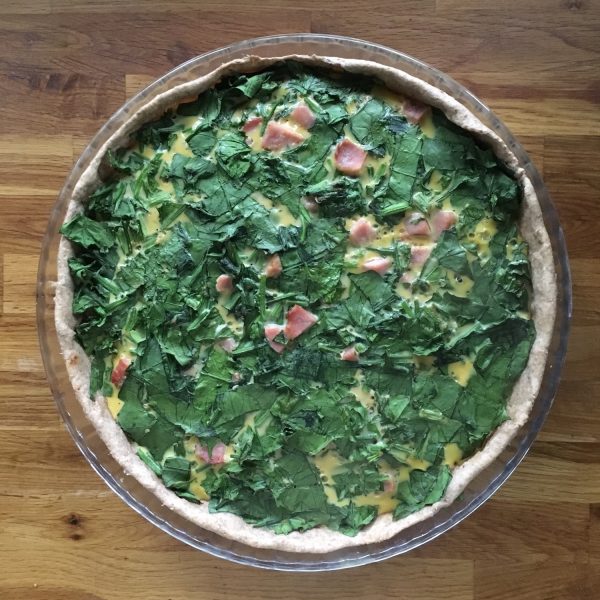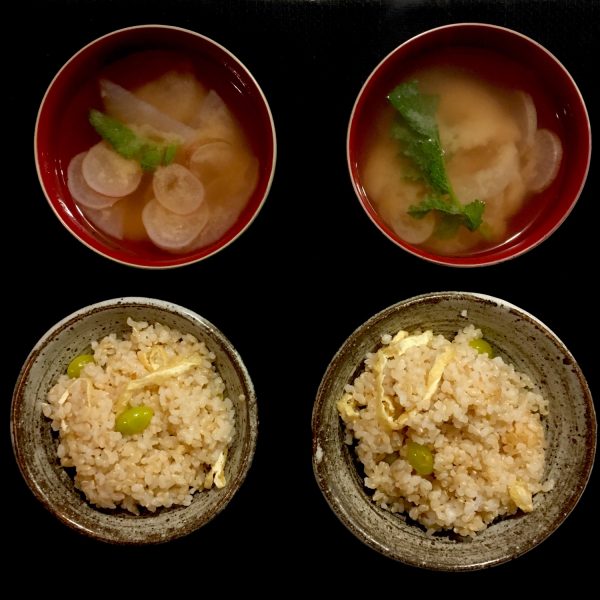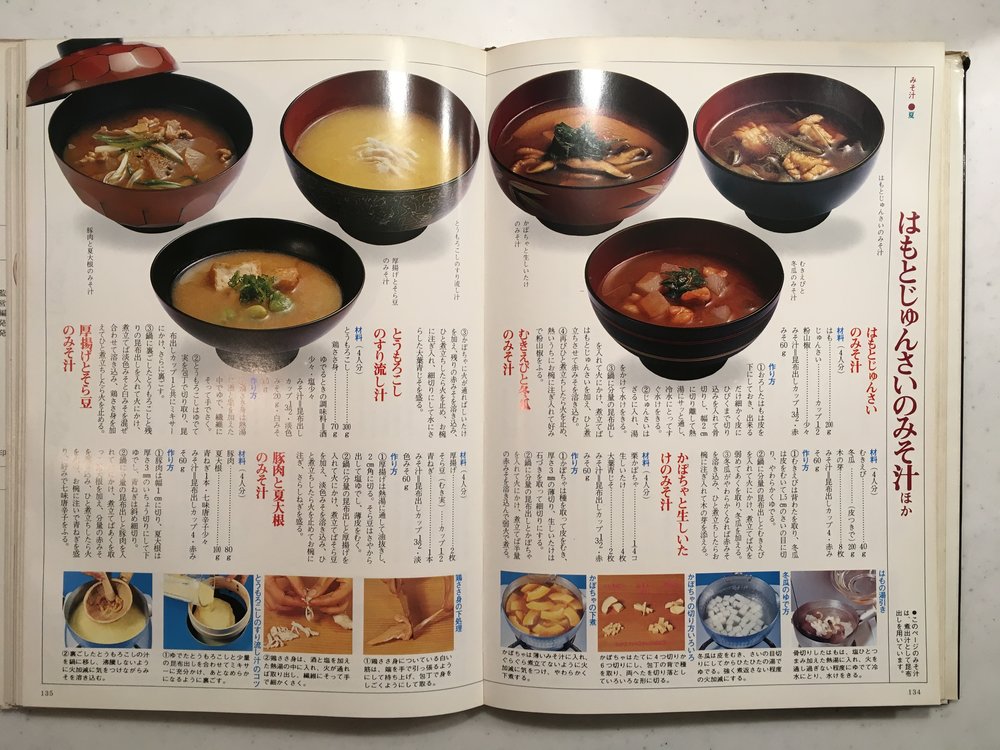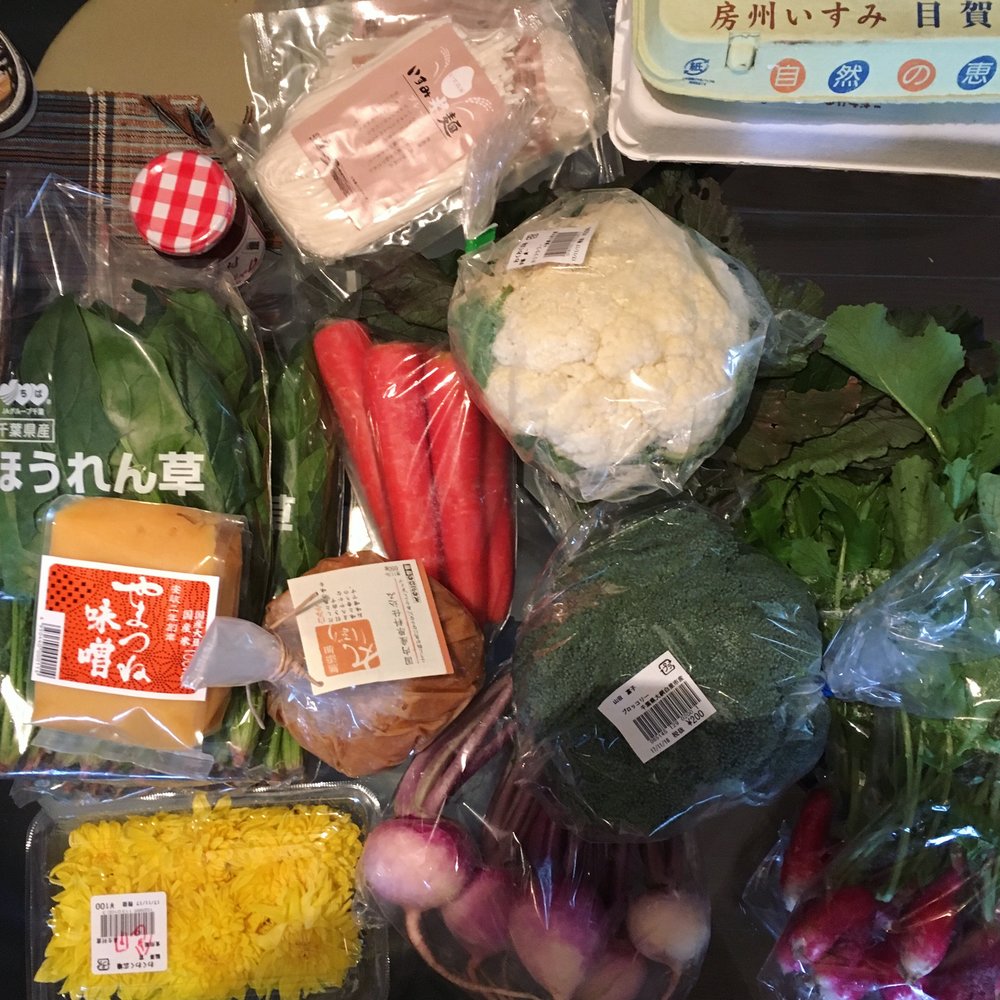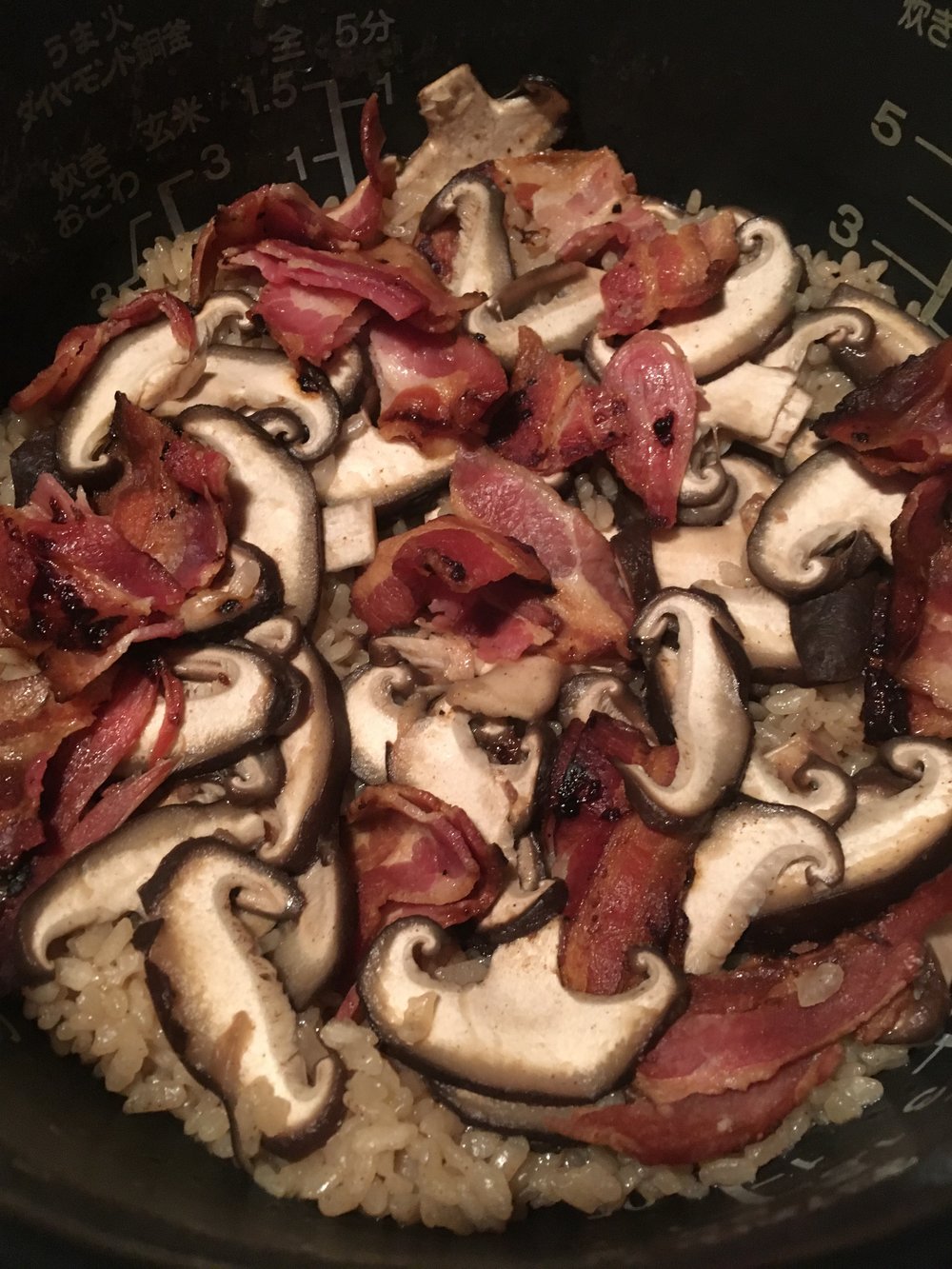We are lucky to have a friend whose parents live in Okinawa and send regularly some delicious, organic products from there. One of the famous staple from okinawa is muscovado sugar (黒糖 こくとう kokuto) . Muscovado sugar is basically unrefined sugar cane, rich in minerals and with a distinctive dark color and a strong taste. Though it sweetens like other sugars, the taste is not neutral and then cannot be used everywhere. But for recipes like plain scones this is a perfect use, and it is nice to keep a few blocks so that it melts when baking. So for this recipe I simply replaced the milk in the scone recipe by a handful of mucovado sugar melted partially in a bit of hot water. Then I simply prepared the scones as usual and eat them with some butter or rose bud jam from Miyakojima too.
Spinach and miso
Last week I had a food shopping spree at Wakuwaku in Otaki, and I bought different types of miso. I love miso, in soup of course, but also as a dip, or in many recipes as an ingredient. This time I used it in two spinach recipes. White miso with spinach and chrysanthemum and regular granulous miso in the egg base of a spinach and ham quiche. It’s the season for chrysanthemums and I like to use them for tr bright yellow and the very distinctive taste they have. They are perfect in a chutney with onions, as an addition to roasted vegetables or here with spinach. So here are my two recipes, both very simple, but if like me you love miso and spinach, they should make you happy.
Spinach and miso quiche:
– a bundle of spinach,
– 3bs of miso (white or regular)
– 3 eggs
– a bit of ham diced (optional)
– flour, butter or olive oil, water for the pie crust
Prepare the pue crust as you like it. I used spelt and whole wheat flour. Roll it to the size of your pie dish. And set it. Wash and chop the spinach, in a bowl beat the eggs with the miso, add the spinach, and the ham, set in the pie crust. Bake at 180deg for 25min. Longer if your pie dish is deep. No need to add salt since the miso is already salty enough.
Spinach and white miso:
– 1 bundle of spinach
– 1 cup of dashi
– 2 flowers of chrysanthemum
– 1tbs of white miso
Wash the spinach a boil them in dashi. In the last minute add the petals of the chrysanthemum flowers. Drain them well, add the miso and stir with the hands. Serve and enjoy with a Japanese meal: rice, grilled fish…
Have a great Sunday!!

Japanese delight
I finally tested a recipe inspired by the cooking book I bought last week on my way home at a bouquinist in Jimbocho. It’s an old book from the 1970’s or 1980’s and it has a lot of very beautifully presented food. Plating changes with time and they certainly had some nice one at that time too!! Though a few a bit crazy… bubble time… The recipes that attracted me much were the miso soup and other clear bouillons. I mean I didn’t actually read much of the recipes, rather I enjoyed reading the explanations about how to choose a good rice and how to cook it very interesting. But the soup section pictures inspired me a lot. One recipe I wanted to try was daikon miso soup. Actually, after years of living in Japan, I finally start to really enjoy cooking daikon. May be because the most often we find is gratted daikon, which I find extremely boring, or simmered and over cooked, but there is so much to do with it. I could now totally go with a daikon week of recipes!!! Would you like that??? Let me know and I’ll be happy to share my favorite classic Japanese recipes and my invented ones!

Today, I’ll just share a simple white miso soup with both radish and daikon, but daikon only, or radish only, works very well too. It is extremely simple and delicious and warm form a chilly evening. You need for 4 serving, 1.5L of dashi (I used simple katsuobushi), a 7cm cut of daikon, 3 large pink radishes, 4 small leaves from the radishes tops (optional), 3tbs of white miso. In a large pan, prepare the dashi. Peel the daikon, cut the piece in half in the lenght to obtain half circle shapes. Cut slices of 1mm in the width. Add to the dashi and cook for 10min. Wash the radishes and slice them. Add to the soup and cook for 4min. Add the washed tops, the miso, stir and serve immediately. If you want to prepare ahead, reduce the cooking time to 7min and 2min. Add the tops and miso after reheating the soup, and serve immediately. I served it with grilles sanma, and briwn rice with fried tofu and gingko nuts.
Vegan gnocchi
When we travel to Sicily last Xmas I bough a small gnocchi board, and curiously enough I haven’t made gnocchi since I have had it. It was time to change that! And the other day with D. and C. at home we discussed about vegan gnocchi, and I was rather tempted to try. The main reason for me was that I usually prepare gnocchi for two, and one egg in the preparation is way to much moisture. And without egg it work actually very well. I also used semolina instead of regular flour and that was really great. I didn’t measure anything, but they were very soft. What is great also without the egg, is that you can dey your gnocchi or at least keep them longer if you don’t eat them all at once!!!
As for accompanying them, for the first batch I only used olive oil and pepper. For the second, cherry tomatoes, broccoli and sausage.

Shopping spree!
With our new work schedule, we finish work quite late on Friday evening and leaving for the country at 23:00, in the cold evening, empty stomachs and drained from the week is not too tempting, so we prefer to wake early on Saturday morning and leave quickly. In the winter fewer people go surfing and golfing that early so it’s not jammed. It is great to drive by day to enjoy the scenery, and we also can stop on the way at local shops we usually don’t go too often. Saturday we stopped at Wakuwaku in Otaki, a shop selling a lot of local products and fresh veggies and fruits, as well as some fish and local pork. Actually we haven’t been for the whole summer, and since we last went they had a total refurbishment and new branding with more organic products too. And it was just crazy! On top of the regular fresh fruits and vegetables I regularly buy, I also bought different types of miso, dry fish, block ham, sausages and locally made rice pasta. They also had tones of preparations such as small fish or shrimp cooked in soya sauce, with walnuts… pickles, tofu… and they had a lottery where I won an other bag full of dried sweet potatoes, rice crackers…


The thing I was the most tempted to try right away was the rice pasta from Isumi. I decided to cook them in a wok of vegetables, with chrysanthemum and sausages. So I boiled and drained the pasta, and kept in cold water. In a wok slightly greased I added 4 little sausages chopped, one red carrot cut in rectangles, a handful of brocoli, a handful of cherry tomatoes, and the petals of two yellow chrysanthemum flowers. Once the sausage were ready, I added one table spoon of soya sauce, then added the drained pasta and stirred well. Served immediately with an other chrysanthemum flower for decor. Simple and delicious!
Have a great week!
Shiitake week! Day 5!
And here is the last recipe of this shiitake week! I could have added many more like shiitake quiche, shiitake soup… But weekend is for new creative cooking… we’ll see tomorrow what the farmers market will inspire us… though I am craving for homemade gnocchi, rich quiche and more takikomi gohan… and I have a new cookbook to browse and some older to look at again (I thinking about my Sicilian cookbook and Shojin cuisine cookbook in particular and some older Japanese cookbooks I haven’t touch in years…) . So this last shiitake recipe is basically using shiitake as substitute for porcini. Of course they have a very different taste but in some preparations they can have a very similar texture. And since there is no porcini in Japan, that finding really delicious matsutake that actually come from Japan (they are usually from Canada, US, Korea or China) has become a challenge, regardless of the price you are eager to pay them, using shiitake is a very straightforwardly simple option. I used them with tomato, to serve with polenta and grilled marlin. I simply sliced them, cooked them in olive oil and add the tomatoes. Cooked until it’s all soft and almost dry. Served with the fish sliced and grilled in a pan, and some polenta. That’s it, and it was delicious!
Have a good weekend!
Shiitake week! Day 4!
Some time ago I was writing about my worst culinary failure ever when I made my first miso eggplants. The recipe came from the very Japanese cooking book I bought. And this book has been very precious for us when we started to live in Tokyo. “Simple & delicious Japanese cooking” by Keiko Hayashi has been my Japanese cooking bible for almost one year. And the very first recipe I tried was a shiitake recipe: takikomi gohan, it was also the very first recipe I shared on our blog back in 2004, one that everyone can make, everywhere there are shiitake. And if 13 years ago you could only find them in asian supermarkets, now they are much easier to find.

Today I have prepared a new version of the classic recipe that is in the book to share with new. It uses all the basic ingredients for takikomi gohan, and the same technique. It is very simple to prepare and it cooks unattended during 50min in the rice cooker, giving plenty of time for doing something else. Here is my recipe (the original recipe)
Shiitake takikomi gohan (for 2 people)
– 6 shiitake
– 1 cup of rice
– 1 cup of dashi
– 1tbs of soya sauce
– 1tbs of sake
– 4 slices of bacon (150g of chicken meat)
– 10 gingko nuts peeled (4 steamed or boiled chestnuts)
Wash and slice the shiitake. Cut the bacon and grill it in a pan until crispy. In the rice cooker add the rice, wash it, add the dashi, the shoyu, the sake, the shiitake, the meat the gingko nuts. Start cooking in normal mode. That’s it!!! Enjoy!
Shiitake week! Day 3!
It’ been quite sometime I didn’t make ravioli right?! And I couldn’t wait any longer to train again… in prevision of my visit to Tuscany next month… And with beautiful shiitake, kabocha season and delicious Isumi pork, it was easy to decide what the fillingwould be: it will be all or nothing! Indeed kabocha and shiitake are a great match, the pork is optional but it had really the perfect balance: sweet and savory! So the recipe is rather simple:
Kabocha and shiitake ravioli:
– 1/4 of kabocha
– 6 shiitake
– 100g of ground pork meat
– 1 egg
– 150g of flour
– olive oil
– water
– salt and pepper
Steam the kabocha and puréed it. Dice the shiitake and roast them in a very little bit of olive oil or nothing. Add them to the kabocha purée. For the pork meat, just cook it in a pan until golden, and add to the mix. Salt, pepper and that’s it. For the pasta I used 150g of flour and 1egg, a little of olive oil and water. It made about 35 large ravioli. I also prepared a little mix of olive oil and parsley to top them and it was really de-li-cious… I’m really crazy about Italian food! And when it is mixed with Japanese…


Shiitake week! Day 2!
When suddenly the weather is chilly in the country, that it’s late and I want some confort food, I usually prepare a hot pasta soup with a clear vegetable bouillon. Leek and carrots are the two main ingredients for the bouillon, but alone they do not provide enough, so I like to add something else. This something else being more than often shiitake. Mushrooms in general are great to prepare when in a rush. They just need to be washed and are really easy to cut: slices, quarters, dice… they are quick to cook too… some are also good raw, but not really shiitake. In my warm soup I added a bit of parsley, and for the pasta I chose some pretty stelline.
You can finish with a bit of gratted parmigiano. Keep warm!

